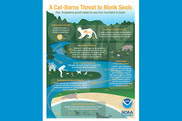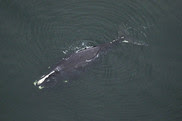Highlights

Eli Asher, Senior Restoration Ecologist for the Cowlitz Tribe, hosted a group of NOAA Fisheries staff on Abernathy Creek, a tributary to the lower Columbia River. The visit showcased progress made by the Cowlitz Tribe since 2008 when they began a habitat restoration project in the watershed to support native salmon and steelhead.
|

For nearly three centuries, Atlantic halibut off New England and Canada were taken for food and sometimes discarded as a nuisance, depending on the market. It proved to be a cyclical fishery: several years of massive landings and discards were followed by many years of fallow seas before the fish would reappear in substantial numbers.
|
|
|
Alaska

Salmon harvest is a lifeline for many in rural Alaska, where subsistence fishing provides food security for communities that otherwise must pay high prices for food staples. The Pacific Coastal Salmon Recovery Fund, funded by Congress and administered by NOAA Fisheries’ West Coast Region, promotes the recovery of Pacific salmon populations that support native subsistence fishing to ensure they remain healthy and sustainable for generations to come.
|
|
|
Pacific Islands

Those who study protected marine species like the endangered Hawaiian monk seal are accustomed to conducting research on beaches and boats. But in their endeavors to research a teeny parasite called Toxoplasma gondii, they are now looking far above the water surface. |
|
|
Southeast

With an unprecedented number of right whale deaths in recent years, avoiding migrating whales is critical to their survival. North Atlantic right whale migration is underway and, as of December 2, biologists have confirmed five sightings of potential right whale moms. The first right whale of the 2019–2020 season was spotted November 23 off Jacksonville, Florida. The 19-year-old female named “ Harmonia” last gave birth in 2016. |
|
|
Greater Atlantic

A dozen scientists and staff members from the Northeast Fisheries Science Center visited the 90-foot F/V Darana R in Point Judith, Rhode Island, on October 3. The stop was a port call in the midst of the fall NorthEast Area Monitoring and Assessment Program (NEAMAP) survey off the coast of Rhode Island.
|

Bluefin tuna is often used as a poster species for the impacts of overfishing. But we have good news for seafood lovers eyeing bluefin sashimi at their local sushi restaurant: U.S.-caught Atlantic bluefin tuna is a sustainable food choice.
|
|
|
Upcoming Deadlines
December 18 Nominations due for the Atlantic Highly Migratory Species SEDAR Pool.
December 20 Nominations due for Outstanding Leaders in Wetland Conservation award.
January 15 Proposals due for ASMFC Regional Pilot Projects in Support of Sustainable Aquaculture.
January 16 Proposals due for Pacific Islands Region’s Marine Education and Training Mini Grant Program.
January 19 Nominations due for MAFAC’s Recreational Electronic Reporting Task Force.
|
|
Upcoming Events
December 2–6 South Atlantic Fishery Management Council meeting in Wilmington, North Carolina.
December 3–5 New England Fishery Management Council meeting in Newport, Rhode Island.
December 4 Texas Trustee Implementation Group Conducting Annual Meeting via Online Video Presentation.
December 5 Public Webinar: 2020 NOAA Community-based Restoration Program Coastal and Marine Habitat Restoration Grants.
December 10–12 Mid-Atlantic Fishery Management Council meeting in Annapolis, Maryland.
December 23 Applications due for participation in 2020 Shark Research Fishery.
January 17 Maine Aquaculture Research, Development, and Education Forum in Belfast, Maine.
February 12–13 West Coast National Electronic Monitoring Workshop in Renton, Washington.
|
|
| |
|

No comments:
Post a Comment